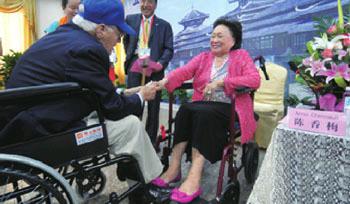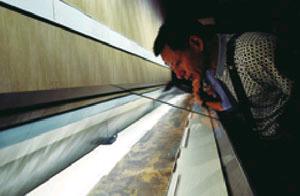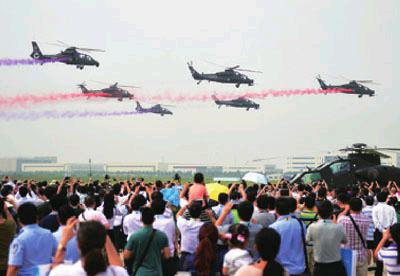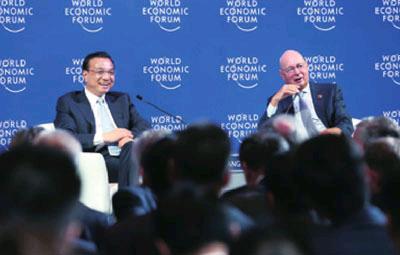Old Friends
2015-10-08
Anna Chan Chennault (right), widow of American general Claire Lee Chennault, who volunteered to fight the Japanese air force in China during World War II, shakes hands with a Flying Tigers veteran in Zhijiang in central Chinas Hunan Province on September 4.
The Flying Tigers, officially known as the American Volunteer Group of the Chinese Air Force, were formed in 1941 and led by Chennault to help China drive out invading Japanese troops.
Big Data Promotion
Chinas cabinet, the State Council, has issued guidelines to boost the development of big data, according to an official statement released on September 5.
The action framework for promoting big data, ratified by Premier Li Keqiang, aims to forge a new model for social governance in the coming five to 10 years, highlighting accurate management and multi-dimensional cooperation.
It stipulates that a trans-departmental data-sharing platform should be formed by the end of 2017 and a unified platform for governmental data should be established before the end of 2018, which will give citizens access to public data resources, including credit, transport, public health, employment, culture, education, science, agriculture, finance and weather services.
China should accelerate the open- ing and sharing of government data to promote the integration of resources and improve governance, boost industrial innovation and foster new business patterns to support economic restructuring, according to the guideline.
To this end, the government will set up an overall coordination mechanism for big data development and application, speed up the establishment of relevant rules, and encourage cooperation between the government, enterprises and institutions, according to the official statement.
China has cultivated several international competitive brands in the big data industry, including 10 world leading enterprises and 500 firms focused on big data application, service and manufacturing.
WWII Museum in Beijing
The International WWII Museum Association (IWMA) was founded in Beijing on September 7 to bring the worlds WWII museums closer and provide a platform for cooperation.
The museums associated with the organization will share materials, hold joint exhibitions and organize seminars and training. The association will also hold celebrations for important anniversaries related to WWII and launch campaigns promoting peace.
IWMA will undertake research, as well as champion the protection of wartime heritage, said Vice Curator Li Zongyuan.
Thus far, the association has 35 member museums in 11 countries, including China, Russia, the United States, Japan and South Korea, according to the Museum of the War of Chinese Peoples Resistance Against Japanese Aggression.
Vaccination Donation
China will donate $5 million to an international vaccine organization to fund vaccinations for 300 million children in developing countries.
The Chinese Government signed the deal with Gavi, the Vaccine Alliance, on September 9.
The money will be donated between 2016 and 2020, to help Gavi with a project that is expected to save 5-6 million lives.
Between 2002 and 2011, Gavi provided China with free Hepatitis B vaccines for more than 25 million newborns in the poorer and remote western part of the country.
The Chengdu Institute of Biological Products provided the Japanese encephalitis vaccine to Laos in April. Another Chinese manufacturer is likely to be pre-qualified by the WHO this year to produce the pneumonia and meningitis vaccine Pneumovax for developing countries in Africa and Southeast Asia.
Insurance for Orphans
More than 70,000 orphans were given free health insurance on September 7 as a new school year gift.
The children from Sichuan Province in southwest China and Guangdong in south China are the latest beneficiaries of a program launched by the Ministry of Civil Affairs (MCA) and the China Children Insurance Foundation in July 2009.
The insurance, which is covered by donations and will last for at least 12 months, is for underprivileged children and MCA-registered orphans. More than 440,000 orphans have benefited from the program since its inception.
Each child is insured for 100,000 yuan ($16,339) at a premium of 50 yuan($7.8) a year to cover the cost of treating 12 critical illnesses, including malignant tumors and conditions requiring organ or stem cell transplants.
The contracts are usually renewed annually.
Closer to the Moon
China is planning to be the first country to land a lunar probe on the far side of the moon, a Chinese lunar probe scientist said on September 8.
The mission will be carried out by Change-4, a backup probe for Change-3, and is slated for launch before 2020, said Zou Yongliao, Deputy Director of the Lunar Exploration Department under the Chinese Academy of Sciences at a deep-space exploration forum on September 8.
The far side of the moon, more commonly known as “dark side of the moon,” is never visible to Earth because of gravitational forces. According to Zou, the far side of the moon has a clean electromagnetic environment, which provides an ideal field for studying low radio frequencies.
Chinas plans to launch the Change-5 lunar probe around 2017 will mark the last chapter in the countrys three-step (orbiting, landing and return) moon exploration program.
Happy Teachers Day
Students in Peizhi School in Luoyang, Henan Province, display cards they made for their teachers to celebrate Teachers Day, which falls on September 10.
Feast Your Eyes
A visitor takes a closer look at the painting Ascending the River on Qingming Festival, one of the most famous paintings in Chinese history, at the exhibition The Precious Collection of the Stone Moat in the Palace Museum in Beijing on September 8.
The exhibition displays many precious masterpieces by ancient artists as part of the 90th anniversary celebration of the Palace Museum.
Military Observer Training
The Ministry of National Defense (MOD) started an international training course on September 7 for military observers of the UN.
More than 40 military personnel, including Chinese training instructors and foreign attachés to China from 22 countries, such as Australia, Denmark and the United States, gathered in Beijing to attend the three-week training course.
The sessions will be conducted in English and oriented around UN peacekeeping missions. Courses cover a range of topics, including case analysis and simulation drills.
Combat exercises will cover 14 themes, such as conflict mediation, field rescue, and kidnap and ransom response. Attendees will be evaluated throughout the course.
The UN has more than 1,800 military observers deployed around the globe. China has dispatched 1,670 military observers since 1990 when it started participating in UN peacekeeping missions.
No Crash to Fear
Premier Li Keqiang sought to soothe global business leaders, saying the governments pledge to prevent the Chinese economy from a hard landing is not empty talk. Li made the remarks in an address to an international audience at the Annual Meeting of the New Champions of the World Economic Forum in Dalian, Liaoning Province, on September 10.
“Although there is turbulence, the overall fundamentals are still upbeat,”Li said.
“Pro-growth policies have started taking effect, positive factors in economic growth are increasing and the economic index has started to pick up from its previous fall,” Li said.
Li said the Chinese Government will make the country the most attractive investment destination. China will con- tinue reforms to achieve a completely convertible capital account, and soon it will allow foreign central banks to directly invest in the interbank foreign exchange market, Li said.
China will establish a yuan crossborder payment system by the end of this year to expand the currencys use in offshore markets.
Premier Li reiterated that the yuans exchange rate will remain stable at a reasonable level and the exchange rate reform is targeting a market-decisive regime rather than starting a worldwide currency war.
Li also said China is driving the global economy, not derailing it.
China is not the source of the present risk in the world economy but rather one of the engines that is pushing its growth, Li said. “The steady growth of the Chinese economy also benefits the world, as the country contributed about 30 percent to the world economys growth in the first half of this year.”
However, he admitted in his speech that the transformation from an economy heavily reliant on investment to an economy fueled by both investment and consumption will be far from a painless process, and it is inevitable for the economy to encounter shifts and turns.
“But the Chinese economy will not see a hard landing. These are not just empty words,” he pledged.
Rising Inflation
Chinas consumer price index (CPI), a main gauge of inflation, increased 2 percent year on year in August, the highest level seen so far in 2015, data from the National Bureau of Statistics(NBS) showed on September 10. On a monthly basis, consumer prices in August rose 0.5 percent.
NBS statistician Yu Qiumei attributed the rise to higher prices of food, including vegetables and pork. “In some regions, alternating heat waves and stormy weather have made an impact on the production and transport of vegetables,” Yu said.
Chinas producer price index (PPI), which measures wholesale inflation, slid 5.9 percent year on year in August, marking the forty-second month of consecutive slides, the NBS said on September 10.
“The widening of the PPI decrease is triggered by a recent sharp fall in commodities prices, slowing fixedasset investment and sluggish external demand,” read a report from Minsheng Securities Research Institute.
Up in the Sky
China-made helicopters drop colored smoke at the opening ceremony of the 2015 China Helicopter Exhibition in north Chinas port city of Tianjin on September 9.
A total of 366 companies from 20 countries and regions participated in the exhibition, with 56 helicopters performing during the event.
Trade Decline Widens
Chinas foreign trade in August dropped 9.1 percent year on year to$333.53 billion, a steeper decline than the 8.2-percent contraction registered in July, General Administration of Customs data showed on September 8.
Exports fell 5.5 percent year on year to $196.88 billion, while imports slumped 13.8 percent to $136.65 billion.
In the first eight months, foreign trade slipped 7.5 percent year on year to $2.56 trillion.
Qu Hongbin, chief China economist at HSBC, attributed the slump in export growth mainly to sluggish external demand, especially exports to the EU and Japan.
Li Hui Yong, an analyst with Shenwan Hongyuan Securities, said weak global demand and falling commodity and primary raw material prices dampened import growth.
Lifting the Stock Market
In a move to guard against extreme market volatility, the China Securities Regulatory Commission (CSRC), the national securities watchdog, announced on September 6 that it is drafting a plan to implement the circuit-breaker mechanism.
The circuit-breaker mechanism refers to a measure adopted by stock exchanges to temporarily halt trading to avert panic selling after the stock index has fallen a certain percentage.
The CSRC said it will strictly control automated program trading, curb excess speculative trading of the stock index futures and better regulate the margin financing business that allows investors to borrow money to trade stocks.
“When the market experiences sharp and abnormal market volatility, the government will not sit aside and let it happen,” the CSRC said in the statement.
China Securities Finance Co., the state-owned margin lender, will continue to stabilize the market through various methods when sharp market volatilities are likely to trigger systemic risks, the CSRC said.
The outstanding value of margin financing also has decreased from the previous peak level of 2.27 trillion yuan ($360 billion) to about 1 trillion yuan ($156.6 billion), indicating that the overall level of risky leveraged trading has shrunk, according to the CSRC.
Only two days later, Chinas central authorities released another support policy in an attempt to boost the volatile stock market.
Starting from September 8, Chinese investors holding a stock for more than one year have been exempted from a 5-percent dividend tax.
Those who have held shares for one month or less will have to pay 20 percent of the dividend they receive as income tax when they sell the shares, according to a statement jointly released by the CSRC, the Ministry of Finance and State Administration of Taxation.
People who have held a stock for one to 12 months will have to pay a 10-percent dividend tax when they sell the stock, the statement said.
The two moves are part of government efforts to promote longterm investment following a market plunge since mid-June. The Shanghai Composite has slumped by more than 40 percent from a peak seen on June 12. The plunge has erased $5 trillion in market value, triggering widespread fears that it could cause a ripple effect amongst global markets.
Lets Talk Business
Chinese Premier Li Keqiang meets with Klaus Schwab, founder and executive chairman of the World Economic Forum, and other global corporate leaders at the 2015 Summer Davos forum in Dalian, Liaoning Province, on September 9.
Financial Leasing
On September 8, the Chinese Government rolled out favorable measures on financial leasing to boost the sector and aid cash-strapped firms.
Authorities will cut red tape, improve regulation and gather support from other financial institutions to accelerate the development of the sector, said a guideline released by the State Council.
The guideline encourages government agencies to purchase and provide public services through financial leasing, adding that legislation for the sector is being considered to improve supervision.
Cheaper and more tailored to borrowers needs than traditional loans, financial leasing is favored by startups and companies with weaker credit.
Local governments should take advantage of new measures, such as interest subsidies, to guide financial leasing businesses to better serve small and medium-sized enterprises, the guideline said.
